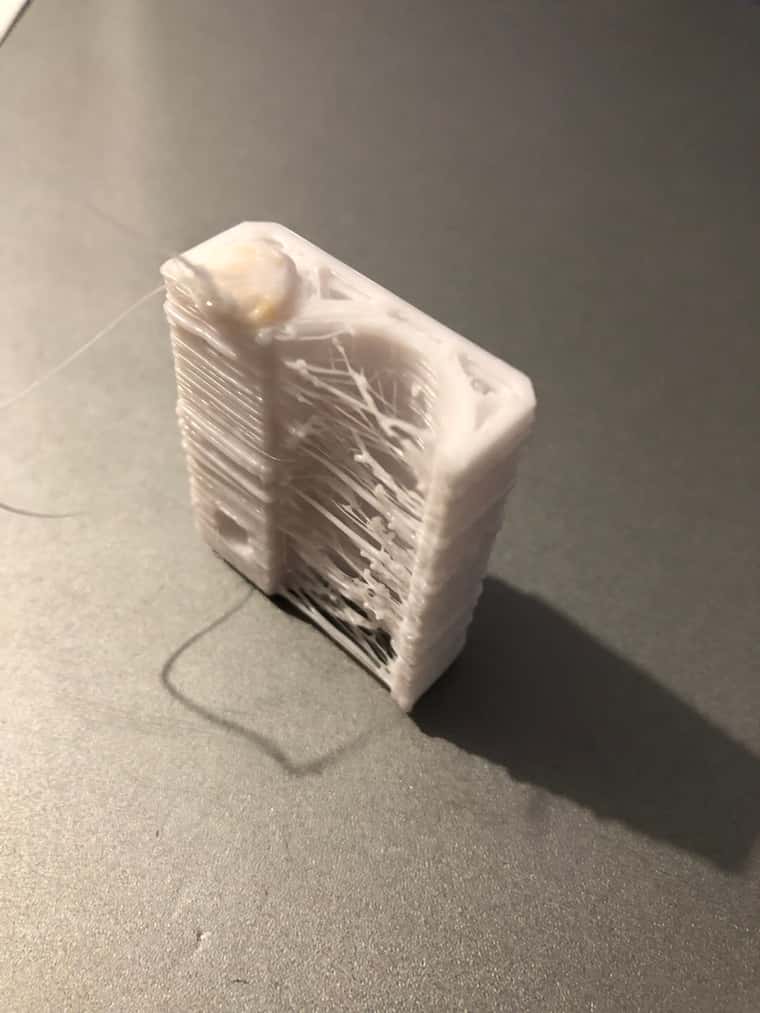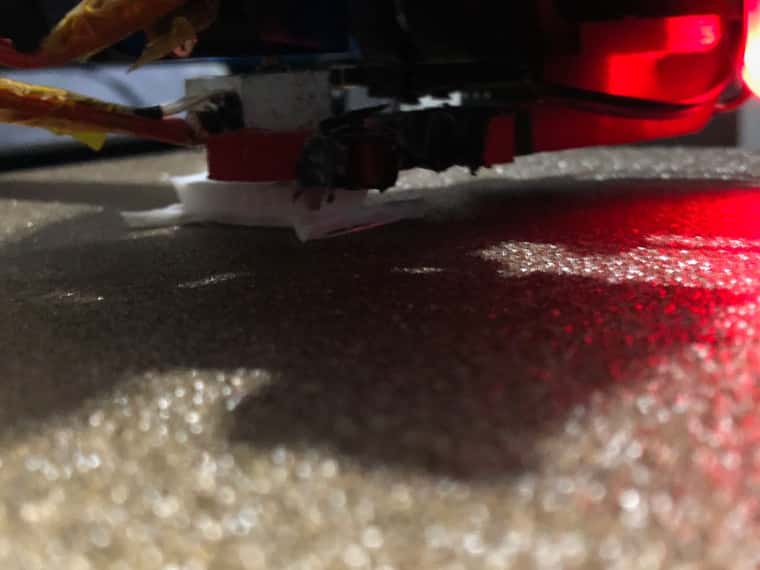The nozzle scratches the part
-
@dc42 Thank you for this comment, I think I had a little problem with my part cooling which wasn’t piloted at the good moment. It’s solved now.
-
@infiniteloop Hi, regarding my previous comment about the part cooling fan, I have finally changed my calibration by calibrating the tool. Like that the calibration is done with both fans. The part cooling is not so bad, but the nozzle always scratches the part… I begin to have less and less hairs…
See below an amazing picture.

There is really a big material bubble. My Bowden extruder has a long pipe (around 500mm). I suspect to have too much pressure with a too long pipe. I will try to install a shorter pipe this week-end. Only to verify if it’s the reason of my problem. I have tried maybe not everything but almost… and begin to loose my mind! -
@redax27 Did you set your slicer to use relative E distances?
-
There is really a big material bubble.
Staring at your "amazing picture", I’m not quite sure of the enormous blob on top: is this a) at the final position of the nozzle after the print was terminated, or b) did you kill the job mid-print due to the blob?
We could ignore case a) for the moment, but TBH, I can’t imagine any reason for case b) to occur.
Apart from this monster blob, the result of your test doesn’t look hopeless. But before my critics, I’d like to confess that I’m no genius at all. That’s why I always try to break down complex phaenomina into manageable parts (which, BTW, is a neat job description for a programmer) - in other words: we should take one step at a time.
Step 1: You had some problem with a (partially) blocked filament flow: can we safely assume this being solved by disabling the part cooling fan? (Else, it’s worthless to focus on other problems.)
OK, in that case, you will have to re-design the air duct of the part cooling fan so that it no longer cools the tip of the nozzle. Until then, you cannot avoid stringing.
Step 2: Your test demonstrates excessive stringing. This cannot be avoided as long as the part cooling fan issue is unresolved. Other counter-measures (reduced temperature of the hotend, retraction settings) need to be taken as well, but for the moment, you should only try to reduce the temperature in steps of 5°C per test print. If this leads to nozzle clogging, go up again.
Step 3: From the beginning of this thread, you keep telling us that „the nozzle scratches the part“. To me, that’s not really obvious from the prints you’ve provided, but this picture

lets me think that there might be some parts of the air duct from your part cooling fan reaching down below the nozzle’s tip. It’s all black in black, so I can’t be sure of that. Maybe you can have a quick look at that?Step 4: Judging from your latest print, I tend to think that the layers are not well aligned in both X and Y. This can indicate a problem with positional reproducibility, in other words: double check the joints of your printer’s frame, tighten the v-rollers and/or the belts, have a look at all moving parts, check proper seating of the screws …
– Admittedly, there’s another explanation for what I observe: you could have printed the object at an insane speed, multiple 100 mm/s at least
 - Sorry, just kidding.
- Sorry, just kidding.Step 5: After resolving my initial question (the blob) and after verifying proper filament flow (step 1), determining a reasonable extruding temperature (step 2), checking the ride height of the fan duct (step 3), and a strong inspection of your printer’s frame and its moving parts (step 4), so after you’ve resolved these basic issues, it’s time to deal with retraction settings and pressure advance, to fine-tune the first layer (mesh bed levelling?) and to fight stringing.
General recommendations: Within each step, only change one parameter at a time. Else, at least I no longer know which measure affected what. And, please stick with a single print model (maybe the benchy) so that you can compare the results. But there’s no rule without exception: to test the quality of a first layer, the object should cover a major area of the print bed, and to test temperature settings for the given combination of hotend and filament, a temperature tower is the model of choice.
Final advice: Don't panic! We've all gone through this, although …
I begin to have less and less hairs…
Absolute beginner! I've advanced to the premium league: don't need no barber any more

-
@ctilley79 Thank you for your comment; this parameter wasn't accessible from my Cura fitted for my core xy printer. I'm not a specialist but when I forced it by replacing M82 by M83 in my start G-Code, the result was catastrophic with strange noises in the extruder and material strange bubbles... I stop it before the end of the first layer. Not sure but I think this change isn't applicable to a core xy printer.
-
@infiniteloop said in The nozzle scratches the part:
Staring at your "amazing picture", I’m not quite sure of the enormous blob on top: is this a) at the final position of the nozzle after the print was terminated, or b) did you kill the job mid-print due to the blob?
it wasn't the last layer. After this bubble appeared, the hot end clogged and I had to stop it. We have case b).
OK, in that case, you will have to re-design the air duct of the part cooling fan so that it no longer cools the tip of the nozzle.Until then, you cannot avoid stringing.
For sure, I have to work to redesign the air duct. In this case the stringing was awaited; I reduce the retraction to let the part building. Before the bubble, the result was what I was looking for. Before having a new fan duct, I'll try to remove completely the part cooling and reduce the retraction (0.8)
lets me think that there might be some parts of the air duct from your part cooling fan reaching down below the nozzle’s tip. It’s all black in black, so I can’t be sure of that. Maybe you can have a quick look at that?
After a quick check, I'm sure my problem doesn't come from the fan duct scratching the part. The scratching comes from the nozzle as I listen to it but not always during the printing.
multiple 100 mm/s at least - Sorry, just kidding.
The printing is not so quick. I have printed it at 50mm/s. Regarding the quality, you're right, I have to tighten the belts again.
Thanks a lot for your advises, I'll come back when I have some other results...

-
After this bubble appeared, the hot end clogged and I had to stop it. We have case b).
That’s not good, because then, the part cooling fan (better: the air duct) is only part of the problem. Something else helps blocking the filament flow over time. At 50 mm/s, it won’t be due to the sheer volume being extruded…
Hm, what about the hotend fans? They are tiny, so that unhindered air flow is mandatory. I can’t determine that from your pictures, but it’s a thing to examine. An additional problem might occur when the hotend fan of tool 1 is triggered at 45°C: If this happens, both fans operate against each other.
-
@infiniteloop To remove some causes, I launch the test as discussed before: the benchy made of PLA+ without part cooling fan and with a lower retraction parameter = 0.8 with all the other parameters as currently used. I begin with a temperature of 205°C. If I have a clogging problem, I remove the clogging and continue with 5°C more.I'm now at 220°C and it has clogged 5 times. The test is finished... We can remove the part cooling fan as the problem source. As you said the hot end cooling fan is small and covers the cylindrical part over the hot end with a commercial covering part made for this feature. As you said, it is triggered at 45°C.
I have already replaced the extruding device to check if it's the problem source and it isn't. The Bowden pipe has been shortened. I could now replace the complete hot end (I have a second one for the other head).
The problem is that I don't understand the reason why... -
@redax27 Well, you have two hotends, equipped with hotend- (not part cooling-) fans facing each other. If the heat of tool 0, which I assume you to use for printing, helps tool 1 to get at or above 45°C, its fan will start working against the air flow from tool 0. It's just a theory, but maybe you can put an eye on that?
-
@infiniteloop As I had problems to begin printing with one hot end the second one is present but totally disabled and mechanically removed. Nothing runs on the second hot end during using the first one.
-
-
This post is deleted!